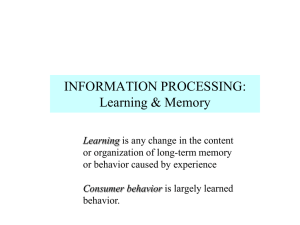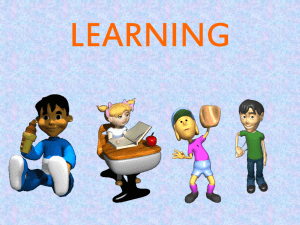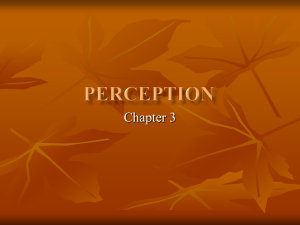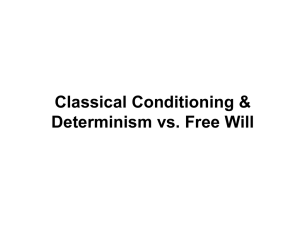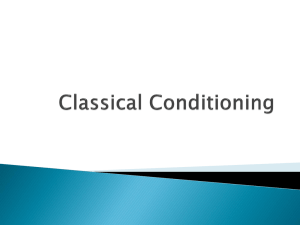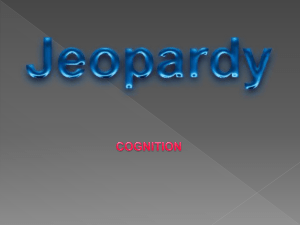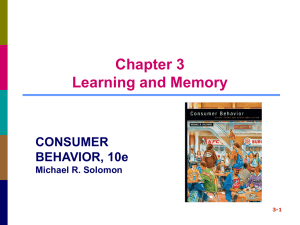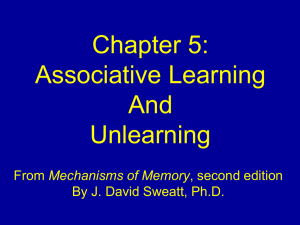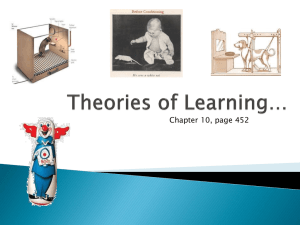Module 3 - socialscienceteacher
advertisement
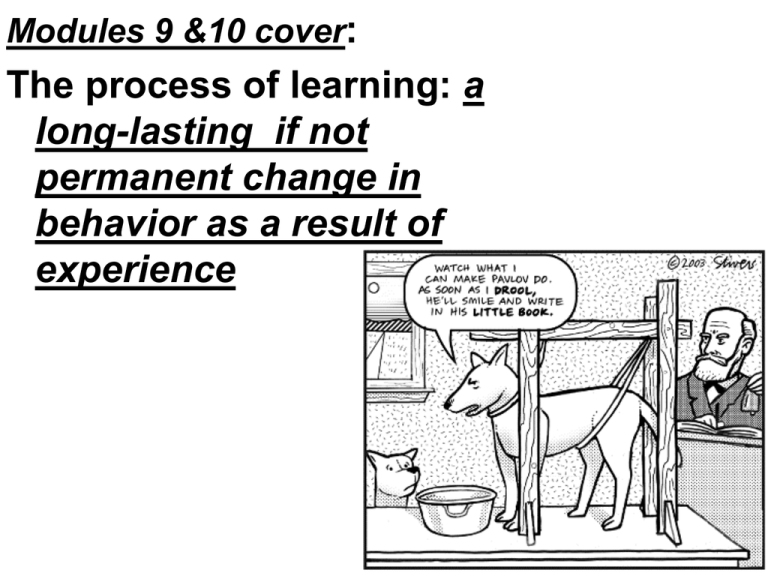
Modules 9 &10 cover: The process of learning: a long-lasting if not permanent change in behavior as a result of experience Module 9 Classical Conditioning 1st of (3) patterns of learning we will explore http://www.youtube.com/watch?v=hhqumfpxuzI THREE KINDS OF LEARNING 1. Classical conditioning: – a kind of learning in which a neutral stimulus acquires the ability to produce a response that was originally produced by different stimulus Ex: With Teacher (x), lot of red ink on a paper signified you failed and you began to panic. Now that you have teacher (y), you get a paper back with a lot of red ink (however this teacher makes a lot of positive comments), yet you begin to feel panic come over you. You are conditioned to red ink. THREE KINDS OF LEARNING 2. Operant conditioning: – learning that relies on the consequences that follow the behavior which either increase or decrease the likelihood that the behavior will continue Ex: If a salesman gets a bonus after every sale, the likelihood is that the salesman will strive to keep what? THREE KINDS OF LEARNING 3. Cognitive learning: – learning that involves mental processes such as attention and memory;learned through observation and imitation;paradoxically it does not require the behavior to be rewarded Ex: A young child regularly observes her mother twirling her hair whenever she reads;curious as to why her mother does this, the young child begins to do the same whenever she reads in class IVAN PAVLOV • Ivan Pavlov: – conducted experiments with dogs where he: 1. Pavlov rang a bell before putting food in a dogs mouth. 2. after numerous trials of pairing the food and bell, the dog salivated to the sound of the bell 3. For the dogs this became a conditioned reflex PROCEDURES OF: CLASSICAL CONDITIONING • Step 1: Choosing stimulus and response Neutral stimulus • a stimulus that causes a sensory response, such as being seen, heard, or smelled, but does not produce the reflex being tested • Ex: perfume/cologne Unconditioned stimulus • USC, some stimulus that triggers or elicits a physiological reflex, such as salivation or eye blink • Ex: the presence of someone you have a crush on Unconditioned response • UCR, unlearned, innate, involuntary physiological reflex that is elicited by the unconditioned stimulus • Ex: when you see this person you become nervous, you sweat, your heart beats faster PROCEDURES OF: CLASSICAL CONDITIONING • Step 2: Establishing classical conditioning Neutral stimulus • During trial, pair neutral stimulus (bell/perfume) with the unconditioned stimulus (food/individual) Unconditioned stimulus • seconds after the (bell/perfume), the (food/individual) is presented as the UCS Unconditioned response • UCS (food/individual) elicits the UCR (salivation/sweats, nervousness) PROCEDURES OF: CLASSICAL CONDITIONING • Step 3: Testing for conditioning Conditioned stimulus • CS, formerly the neutral stimulus that has acquired the ability to elicit a response that was previously elicited by the unconditioned stimulus. Ex: the perfume now has the same effect as the mere sight of the person you desire Conditioned response • CR, (salivation/nervousness, sweats), formerly brought on by UCS (food/person), is now elicited simply by hearing the (bell), or smelling that persons (cologne/perfume) OTHER CLASSICAL CONDITIONING CONCEPTS Generalization – tendency for a stimulus that is similar to the original conditioned stimulus to elicit a response that is similar to the conditioned response Ex: perfumes/colognes that are similar to the one your object of affection wore Discrimination – occurs during classical conditioning when an organism learns to make a particular response to some stimuli but not to others Ex: the smell of Lysol or deodorant will not cause your CR (conditioned response) OTHER CLASSICAL CONDITIONING CONCEPTS Extinction – refers to a procedure in which a conditioned stimulus is repeatedly presented without the unconditioned stimulus and, as a result, the conditioned stimulus tends to no longer elicit the conditioned response Ex: everybody is wearing the perfume/cologne so it losses its effect on you Spontaneous recovery – tendency for the conditioned response to reappear after being extinguished even though there have been no further conditioning trials Ex: months later, you smell the perfume/cologne and you instantly become excited REAL-WORLD OCCURRENCES Taste aversion learning – refers to associating a particular sensory cue (smell, tastes, sound, or sight) with getting sick and thereafter avoiding that particular sensory cue in the future Examples: 1. Eating something (4 cheese pizza), then becoming ill; conditioning you to feel ill every time you see smell (4 cheese pizza) 2. Over-drinking (and getting sick) from a specific type of alcohol; forces you to avoid that drink 3. Eating something poisonous; some researchers believe we are wired to develop taste aversions to poisons? ADAPTIVE VALUES & USES: How is CC useful? CONDITIONED EMOTIONAL RESPONSE – Feeling some positive or negative emotion, such as happiness, fear, or anxiety, when experiencing a stimulus that initially accompanied a pleasant or painful event. Examples: 1. years from now you will feel nostalgic when hearing a song played at your prom. 2. You become instantly frightened when you see/hear a police car behind you. 3. You remember the smell of a funeral home experienced after losing someone special. Theories of EXPLANATION FOR CC • Theories of classical conditioning – Stimulus substitution • stimulus substitution means that a neural bond or association forms in the brain between the neutral stimulus (bell) and unconditioned stimulus (food) The bell Substitutes for the food Theories of EXPLANATION FOR CC • Cognitive perspective - says that an organism learns a predictable relationship between two stimuli such that the occurrence of one stimulus (neutral stimulus) predicts the occurrence of another (unconditioned stimulus) the perfume predicts that your heartthrob will be arriving soon Stimulus Substitution Theory Contiguity Theory Cognitive Perspective Stimulus Substitution: A neutral bond or association forms in the brain between the NS and UCS. After repeated trials, the NS becomes the CS and acts like a substitute for the UCS. Thereafter , the CS elicits a CR that is similar to that of the UCR. Contiguity Theory: Classical Conditioning occurs because 2 stimuli (NS and UCS) are paired close together in time (are contiguous. As a result of this stimulus, which elicits the CR. Cognitive Perspective: An organism learns a predictable relationship between 2 stimuli such that the occurrence of one stimulus (NS) predicts the occurrence of another (UCS). In other words, classical conditioning occurs because the organism learns that to expect. Ex. Bell Substitutes for food Ex. Seeing a Pizza is paired closely in time with eating it Ex. The bell predicts food is coming Little Albert Little Albert Little Albert Experiment – In the early 1920s J.Watson introduced a 9 month-old child to a famous experiment highlighting the theory of C.C. Steps: 1. Albert has no fear or rage towards rats, rabbits, dogs or anything w/white fur. 2. Watson begins to condition Albert so that whenever he sees a white rat (NS)he bangs a hammer on a metal bar (UCS) he cries (UCR). 3. After multiple experiences, whenever Albert sees the rat (now the CS) he begins to cry (CR) even if there is no accompanying metal bang. 4. The end observable result indicated that attached to little Albert’s fear of the rat was also fear or (generalization) towards anything that resembled the rat. Systematic Desensitization Procedure; Three Steps Step 1: Learning to Relax Ex. Relaxing sets of muscles at a time on cue. Step 2: Making an Anxiety Hierarchy Step 3: Imagining and Relaxing Ex. Ex. A list of things that are stressful, listing them in Combining the relaxation and imagining the list order. of stressful things going through each thing on the list.
